A Lizard's Tale, a Lost (P)ART: The Ending to be Told
A Lizard's Tale, a Lost (P)ART: The Ending to be Told
By the Wildlife and Industry Together (WAIT)
September 6, 2016
This is not an old wives’ tail, but actually fact more than fiction. The process of regeneration has fascinated doctors and scientists for decades for the concept might have human application some day. No telling where this research could end.
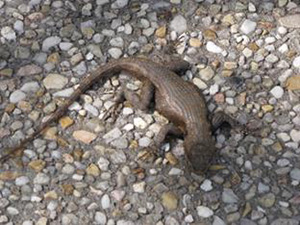
Photo courtesy of Bill Willis
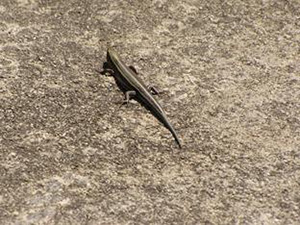
Photo courtesy of Bill Willis
North Carolina is home to twelve (12) species of lizards, but only eight (8) are found in the Piedmont region. Lizards are diurnal seeking shelter and protection at night. On most early summer days expect to see a lizard basking in the sun to warm up. Once warm, they are pretty fast reptiles. Speed allows for securing food and escaping harm. Get too close and they disappear. Try to catch and you may only get a tail tip and a painful bite to the finger. The tail tip will regrow and the finger will heal, but pride is lost forever. Although considered predators, they too are prey for birds, small mammals, snakes, other lizards and even fire ants.
Doctors Foster and Smith offer the following information: Lizard Tail Loss: Why It Happens & What To Do
Where does the tail separate? “Lizards that can drop their tail have "fracture planes" spaced regularly down the length of the tail. These are either between vertebrae or in the middle of each vertebra, depending on the species, and it is at these points where the break can occur. Skin, muscles, blood supply, nerves, and bone separate when the tail is dropped. After it falls to the ground, the tail starts to wiggle and move on the ground, hopefully giving the lizard a chance to escape while the predator is focused on the moving tail”.
What is the effect and process of healing? “Tail loss, though natural, does cause some issues for the lizard. First, it will generally affect the lizard's sense of balance, and it may have trouble climbing or walking regularly until it adjusts to the lack of a tail.
For a lizard that stores fat in its tail (gecko), it also results in the loss of critical fat deposits. Juvenile lizards stop growing while the tail is healing and regenerating, and, in adults, the reproductive processes stop. Healing and regenerating the tail also takes a significant amount of energy, or protein, so lizards that have dropped their tail are at a greater threat for nutritional deficiencies."
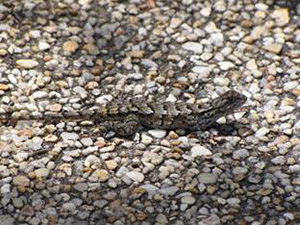
Photo courtesy of Bill Willis
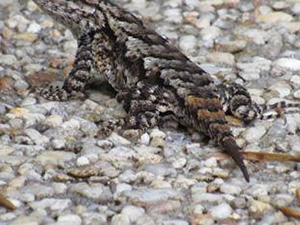
Photo courtesy of Bill Willis
Is the new tail different? Even if a lizard can grow a new tail, it’s generally not the same length or color as it was before, and it may have abnormal scales or patterns. If the tail is going to regenerate, it should do so quickly,” for it is a wound healing process. A tail that has been regenerated has a rod of cartilage in it rather than bone. The tail will not be able to break in the replaced section, but if “fracture planes” exist closer to the body, separation may occur again.
How long does it take to regrow a tail? It depends on the age, species, and how much was lost. It could take between a month and a year to be replaced.
What lizards might be seen around campus? Despite being very elusive creatures, you should see a couple of our native lizards on campus especially in the Memorial Garden, patio areas, and wood-lines. Take a picture if you can, for the juveniles look similar and may require a second look. The glass lizard hasn’t been reported yet.
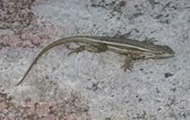
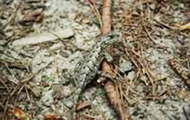
Sceloporus undulatus - fence swift, sometimes referred to as the prairie lizard, gray lizard, fence lizard, or pine lizard deserves its name. It is a medium-sized lizard found in open sunny areas along forest edges, rock piles, and rotting logs or wooden fences. Several make the Memorial Garden their home. Check around the trashcan there. Food consists of spiders, grasshoppers, snails, beetles, and caterpillars.

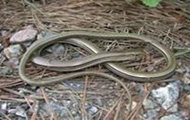
Ophisaurus attenuatus - slender glass lizard has no legs and looks like a snake, except they have eyelids and external ear openings. Mature lizards can be four feet long. These are very active and the tail is lost very easily. Spouses who don’t like snakes, won’t accept these lizards very willingly. Can be found in grassy fields and dry woodlands. There have been no reports of these on campus. Food consists of other lizards, snakes, bird eggs, mice, and invertebrates.
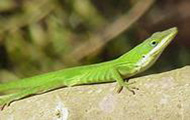
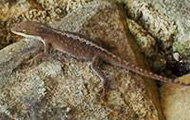
Anolis carolinensis - Carolina anole, a plant climbing lizard, is frequently called the green anole, American anole, red-throated anole, or American chameleon. The term chameleon applies to its ability to change color from several brown hues to bright green and its somewhat similar appearance (though it is not a true chameleon). This lizard can be kept in an aquarium if the proper husbandry conditions are maintained. These animals frequent the campus shrubs and barberry plants. Food consists of small insects and spiders.
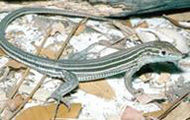
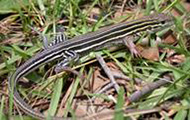
Cnemidophorus sexlineatus - six-lined racerunner is another speedster. Getting a good look is often difficult. They somewhat resemble the skinks. The stripes are yellowish and the tail is very long, slim and bluish in juveniles. As adults the blue is lost. They are at home on the ground in woodlands, grasslands or on rocky outcroppings. Food consists of insects and spiders.
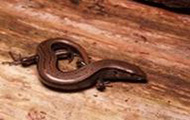
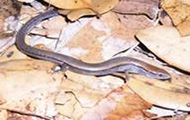
Scincella lateralis - grounds skink has no name grabbing lines but is a shiny coppery brown with a dark dorsolateral stripe. It is our smallest lizard and can be found in open but wooded areas with plenty of mulch, but always close to the ground. Food consists of grubs, spiders, isopods and small insects.
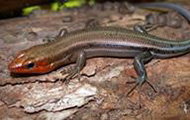
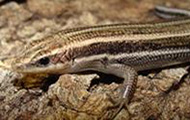
Plestiodon fasciatus - American five-lined skink is an indigenous reptile of Virginia and the Carolinas. The three skinks are hard to tell apart in the wild because the appearance changes with age, sex, and time of year. The juvenile of this species have a brilliant blue tail. Both the stripes and blue tail are lost in mature males and the head becomes red. While this lizard has five (5) stripes, the other skinks usually have seven (7).
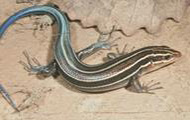
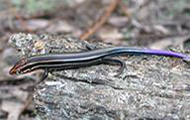
Plestiodon inexpectatus - southeastern five-lined skink is blue-tailed as a juvenile with five plus two lighter stripes for seven total. The stripes fade on older animals. They can be found in disturbed wooded areas and old home sites. Food consists of insects and spiders.
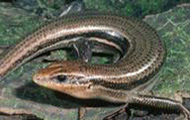
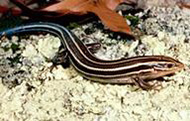
Plestiodon laticeps - broadhead skink is the largest of the three skinks up to 13 inches. It is arboreal and can be found high in trees. It likes dry locations. Food consists of insects, invertebrates and lizards.
These different lizards are not known to play together or socialize like the turtles do. They do compete for food and space, however. Whether males establish territory beyond the mating period is up for further discussion.
Sorry, No Gators Allowed

Not Found in the Piedmont
Plestiodon anthracinus (coal skink) found in the MOUNTAINS
Ophisaurus ventralis (eastern glass lizard) LEGLESS found in the COASTAL PLAINS
Ophisaurus mimicus (mimic glass lizard) LEGLESS found in the COASTAL PLAINS
Phrynosoma cornutum (Texas horned lizard), an introduced species, found in the COASTAL PLAINS
Credit to the Davidson College website Lizards of North Carolina, created by: J. Willson, Y. Dornlev, W. Anderson, G. Connette and E. Eskew



